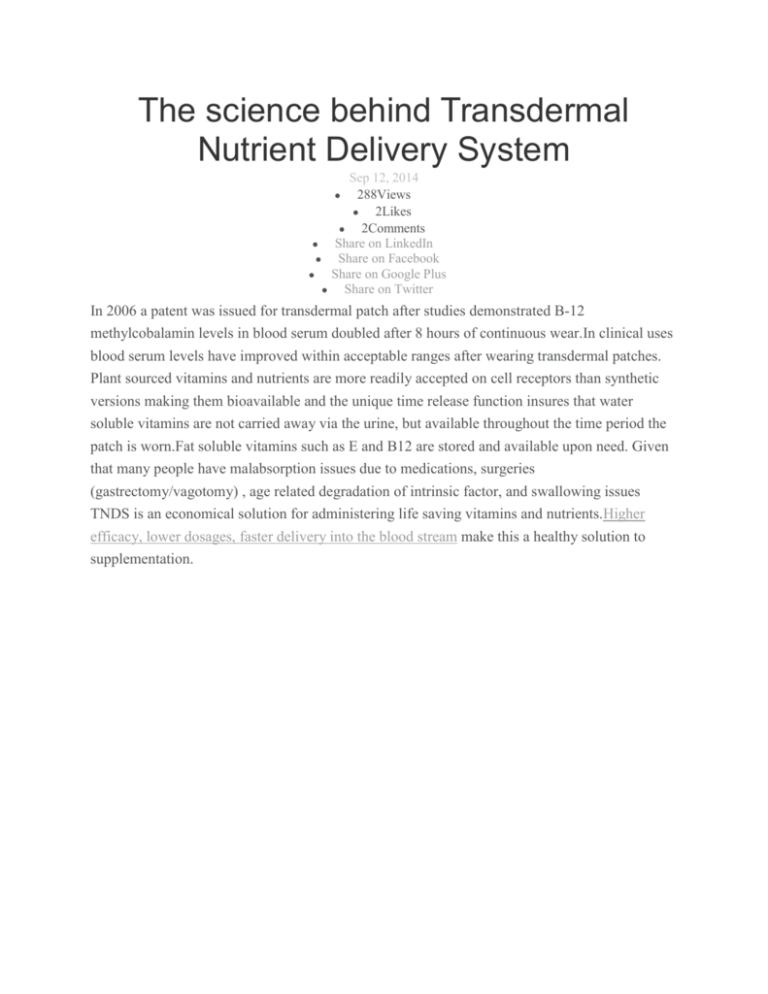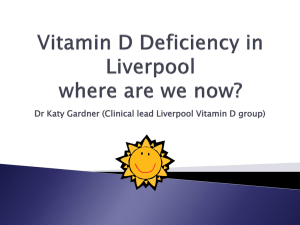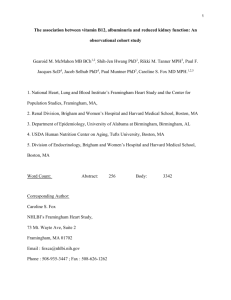The Science Behind Transdermal Nutrient
advertisement

The science behind Transdermal Nutrient Delivery System Sep 12, 2014 288Views 2Likes 2Comments Share on LinkedIn Share on Facebook Share on Google Plus Share on Twitter In 2006 a patent was issued for transdermal patch after studies demonstrated B-12 methylcobalamin levels in blood serum doubled after 8 hours of continuous wear.In clinical uses blood serum levels have improved within acceptable ranges after wearing transdermal patches. Plant sourced vitamins and nutrients are more readily accepted on cell receptors than synthetic versions making them bioavailable and the unique time release function insures that water soluble vitamins are not carried away via the urine, but available throughout the time period the patch is worn.Fat soluble vitamins such as E and B12 are stored and available upon need. Given that many people have malabsorption issues due to medications, surgeries (gastrectomy/vagotomy) , age related degradation of intrinsic factor, and swallowing issues TNDS is an economical solution for administering life saving vitamins and nutrients.Higher efficacy, lower dosages, faster delivery into the blood stream make this a healthy solution to supplementation. "From the abstract"[0036] Analysis of the averaged results shows an approximately linear increase in vitamin B12 blood levels (pg/ml) over the 8-hour period. Analysis of the raw data from this study allows for the following observations. [0037] Vitamin B12 consistently increased in each subject trial over the 8-hour period. At the end of 8 hours, vitamin B12 levels had about doubled, from about 700 pg/ml to about 1,400 pg/ml. [0038] The rate of vitamin B12 delivery varied between subjects by as much as five-fold. The high variation in vitamin B12 absorption suggests such variation can be extrapolated to the general population. With only six test subjects (including four test subjects with 2 repeated trials), the extent and causes of variation in the delivery of vitamin B12 were difficult to ascertain. The causes of variation were likely due to differences in the skin of test subjects; however, variations due to the vitamin B12 patches themselves was ruled out. [0039] A statistical one-way analysis was conducted of the variance of the experimental data, comparing vitamin B12 absorption for the first two hours with the last two hours. The results show the increase in absorption was significant, with a probability of error in rejecting the null hypothesis (that proper absorption was occurring) being about 0.01 (F=7.97). This shows a high statistical significance and indicates that patches enable absorption of vitamin B12 as designed. [0040] Described herein is a transdermal vitamin B12 delivery patch 10, which includes a fabric backing 12, a skin-adhesive polymer matrix 14 on one side of the fabric backing, and a vitamin B12 compound contained within the skin-adhesive polymer matrix, where the vitamin B12 compound diffuses from within the skin-adhesive polymer matrix through the stratum corneum layer of the epidermis into the dermis and into the microvascular of the user. A release liner optionally protects the integrity of skin-adhesive polymer matrix and the vitamin B12 compound therein before patch is adhered to the user's skin. " Immune booster Three studies have shown that transdermal delivery of nutrients have a higher efficacy than oral supplementation and using food sourced nutrients insure that cell receptors accept them.The science firmly supports the use of lipid/fat coated polymer based micro-needles for delivering micro nutrients directly into the blood stream, bypassing the hepatic pathway. 1) Department of Pharmacology, University of Dublin (2) Tudhope GR, Swan HT, Spray GH. Patient variation in pernicious ananemia as shown in a clinical trial of cyanocobalamin, hydroxocobalamin and cyanocobalamin-zinc tannate. Br J Haematol. 1967 Mar;13(2):216-28. 3)Gastroenterol Hepatol. 2014 Sep;37 Suppl 3:3-13. doi: 10.1016/S0210-5705(14)70078-0. [Motility and functional gastrointestinal disorders]. [Article in Spanish]Mearin F1, Rey E2, Balboa A3." In the therapeutic area, the importance of diet for these patients (FODMAP, fructans, etc.) is once again confirmed, and data is provided that backs the efficacy of already marketed drugs such as linaclotide, which rule out the use of other drugs such as mesalazine for patients with irritable bowel syndrome. This year, new forms of drug administration have been presented, ......... and granisetron transdermal patches for patients with gastroparesis." Abstract Transdermal drug delivery has made an important contribution to medical practice, and is poised to fully achieve its potential as an alternative to oral delivery and hypodermic injections. Firstgeneration transdermal delivery systems have continued their steady increase in clinical use for delivery of lipophilic, low-dose drugs and now nano technology is advancing nutrient and vitamin delivery. . Second-generation delivery systems using chemical enhancers, non-cavitational ultrasound and iontophoresis have also resulted in clinical products; the ability of iontophoresis to control delivery rates in real time provides added functionality. Thirdgeneration delivery systems target their effects to skin’s barrier layer of stratum corneum using microneedles, thermal ablation, microdermabrasion, electroporation and cavitational ultrasound. Microneedles and thermal ablation are currently progressing through clinical trials for delivery of macromolecules and vaccines, such as insulin, parathyroid hormone and influenza vaccine. Using these novel second- and third-generation enhancement strategies, transdermal delivery is poised to significantly increase impact on vitamin and nutrient delivery. Using advances in nano-technology Health Flex released on 9-15 2014 another significant advance in TNDS, vitamin D3 with calcium and magnesium.Health Flex A Wellness company is a leader in providing economical solutions to nutrient delivery problems. Nat Biotechnol. Author manuscript; available in PMC Jun 23, 2009. Published in final edited form as: Nat Biotechnol. Nov 2008; 26(11): 1261–1268. doi:10.1038/nbt.1504PMCID: PMC2700785NIHMSID: NIHMS121685 Transdermal delivery Mark R. Prausnitz1 and Robert Langer2 Author information ► Copyright and License information ► Protein encapsulation in polymeric microneedles by photolithography Jaspreet Singh Kochhar,1 Shui Zou,2 Sui Yung Chan,1 and Lifeng Kang1 Conclusion We have demonstrated the amenability of our photilithographic technique to encapsulate protein drugs. Drug distribution was found to be uniform across the microneedle array. Moreover, the process was proven to maintain protein stability and is hence expected to retain the biological activity of the encapsulated proteins. The encapsulated protein was released and permeated through the skin in much larger amounts as compared with passive diffusion. In vitro biocompatibility of the polymeric microneedles has been demonstrated by the low cytotoxicity of the polymeric extracts on different cell lines, indicating the safety of these microneedles. In conclusion, the prepared microneedles are expected to serve as a potentially useful drug delivery system to deliver biological drugs. Abstract Background Very few over-the-counter cosmetic ‘anti-ageing’ products have been subjected to a rigorous double-blind, vehicle-controlled trial of efficacy. Previously we have shown that application of a cosmetic ‘anti-ageing’ product to photoaged skin under occlusion for 12 days can stimulate the deposition of fibrillin-1. This observation infers potential to repair and perhaps clinically improve photoaged skin. Objective A cosmetic ‘anti-ageing’ product improves photoaged skin: a double-blind, randomized controlled trial REB Watson, S Ogden, LF Cotterell, JJ Bowden, JY Bastrilles, SP Long,* and CEM Griffiths Author information ► Article notes ► Copyright and License information ►This article has been cited by other articles in PMC. Results In the 12-day patch test assay, we observed significant immunohistological deposition of fibrillin-1 in skin treated with the test product and RA compared with the untreated baseline (P=0·005 and 0·015, respectively). In the clinical RCT, at 6 months, the test product produced statistically significant improvement in facial wrinkles as compared to baseline assessment (P = 0·013), whereas vehicle-treated skin was not significantly improved (P = 0·11). After 12 months, there was a significant benefit of the test product over that projected for the vehicle (70% vs. 33% of subjects improving; combined Wilcoxon rank tests, P=0·026). There was significant deposition of fibrillin-1 in skin treated for 6 months with the test product [(mean ± SE) vehicle 1·84 ± 0·23; test product 2·57 ± 0·19; ancovaP=0·019). Conclusions In a double-blind RCT, an over-the-counter cosmetic ‘anti-ageing’ product resulted in significant clinical improvement in facial wrinkles, which was associated with fibrillin-1 deposition in treated skin. This study demonstrates that a cosmetic product can produce significant improvement in the appearance of wrinkles and further supports the use of fibrillin-1 as a robust biomarker for the repair of photoaged dermis. Keywords: fibrillin-1, patch-test assay, randomized controlled trial, wrinkles Methylcobalamin (mecobalamin, MeCbl, or MeB) is a cobalamin, a form of vitamin B. It differs from cyanocobalamin in that the cyanide is replaced by a methyl group.[1] Methylcobalamin features an octahedral cobalt(III) centre. Methylcobalamin can be obtained as bright red crystals.[2] From the perspective of coordination chemistry, methylcobalamin is notable as a rare example of a compound that contains metal-alkyl bonds. Nickel-methyl intermediates have been proposed for the final step of methanogenesis. Methylcobalamin is equivalent physiologically to vitamin B, and can be used to prevent or treat pathology arising from a lack of vitamin B (vitamin B12 deficiency), such as pernicious anemia. Methylcobalamin is also used in the treatment of peripheral neuropathy, diabetic neuropathy, and as a preliminary treatment for amyotrophic lateral sclerosis. Source: https://www.linkedin.com/pulse/20140912141933-209684125-the-science-behindtransdermal-nutrient-delivery-system









